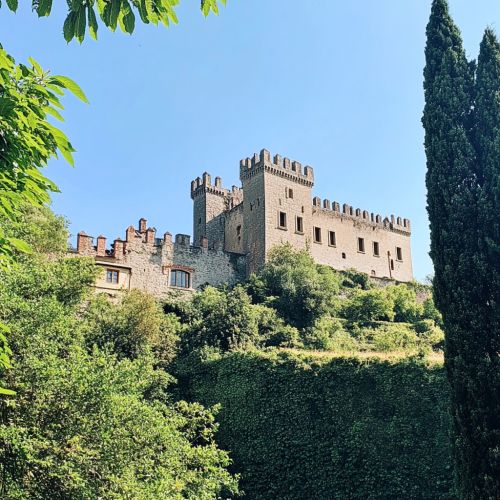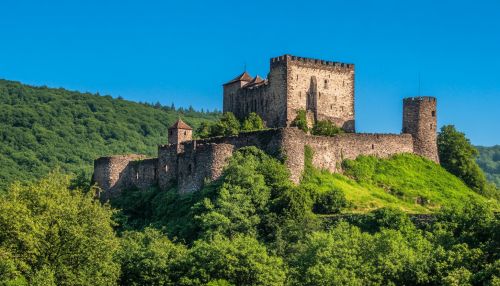Malaspina family: Difference between revisions
No edit summary |
No edit summary |
||
| Line 15: | Line 15: | ||
The Malaspina family was known for their involvement in the [[Guelphs and Ghibellines]] conflict, a series of civil wars and political struggles between supporters of the Papacy (Guelphs) and the Holy Roman Emperor (Ghibellines). The family's allegiance shifted over time, reflecting the complex and often volatile political landscape of medieval Italy. | The Malaspina family was known for their involvement in the [[Guelphs and Ghibellines]] conflict, a series of civil wars and political struggles between supporters of the Papacy (Guelphs) and the Holy Roman Emperor (Ghibellines). The family's allegiance shifted over time, reflecting the complex and often volatile political landscape of medieval Italy. | ||
[[Image:Detail-98339.jpg|thumb|center|A medieval castle on a hill, surrounded by lush greenery and a clear blue sky.]] | [[Image:Detail-98339.jpg|thumb|center|A medieval castle on a hill, surrounded by lush greenery and a clear blue sky.|class=only_on_mobile]] | ||
[[Image:Detail-98340.jpg|thumb|center|A medieval castle on a hill, surrounded by lush greenery and a clear blue sky.|class=only_on_desktop]] | |||
== Cultural Contributions == | == Cultural Contributions == | ||
Latest revision as of 08:40, 9 October 2024
Introduction
The Malaspina family is a historically significant noble lineage originating from Italy, particularly influential during the Middle Ages and the Renaissance. Known for their extensive landholdings and political influence, the Malaspina family played a crucial role in the history of the Ligurian and Tuscan regions. Their legacy is intertwined with the development of feudal systems, the patronage of the arts, and the intricate politics of medieval Italy. This article delves into the origins, history, and impact of the Malaspina family, providing a comprehensive examination of their contributions to European history.
Origins and Early History
The Malaspina family's roots can be traced back to the Lombard period in Italy. The family is believed to have descended from the Obertenghi, a prominent noble family in the Lombardy region. The first documented mention of the Malaspina family dates back to the 10th century, with the figure of Oberto I, who held the title of Margrave of the East. The family's name is thought to derive from the Latin "Mala Spina," meaning "bad thorn," possibly referencing a thorny plant or a defensive position.
During the 11th century, the Malaspina family began to consolidate their power and influence in the regions of Lunigiana and the Apennines. They established a feudal domain that stretched across parts of modern-day Liguria, Tuscany, and Emilia-Romagna. The family's strategic marriages and alliances with other noble houses further solidified their status and territorial control.
Expansion and Influence
By the 12th century, the Malaspina family had become one of the most powerful feudal lords in northern Italy. Their territories were divided among various branches of the family, each controlling different castles and lands. The family's influence extended beyond their immediate domains, as they played a significant role in the politics of the Holy Roman Empire and the Papal States.
The Malaspina family was known for their involvement in the Guelphs and Ghibellines conflict, a series of civil wars and political struggles between supporters of the Papacy (Guelphs) and the Holy Roman Emperor (Ghibellines). The family's allegiance shifted over time, reflecting the complex and often volatile political landscape of medieval Italy.


Cultural Contributions
The Malaspina family were notable patrons of the arts and literature. Their courts were centers of cultural activity, attracting poets, artists, and scholars. One of the most famous figures associated with the Malaspina family is the poet Dante Alighieri, who visited the court of Moroello Malaspina during his exile from Florence. Dante's interactions with the Malaspina family are immortalized in his literary masterpiece, the Divine Comedy, where he praises their hospitality and noble virtues.
The family's patronage extended to the construction and embellishment of churches, monasteries, and castles. These architectural projects not only demonstrated their wealth and power but also contributed to the cultural and artistic heritage of the regions under their control.
Decline and Legacy
The decline of the Malaspina family's power began in the late Middle Ages, as the rise of centralized states and the decline of feudalism eroded their traditional sources of authority. The family's territories were gradually absorbed by larger political entities, such as the Republic of Genoa and the Duchy of Milan. Despite this decline, the Malaspina family continued to hold noble titles and maintain a presence in Italian society.
Today, the legacy of the Malaspina family is preserved in the numerous castles and historical sites that bear their name. These sites serve as a testament to the family's historical significance and their enduring impact on the cultural landscape of Italy.
